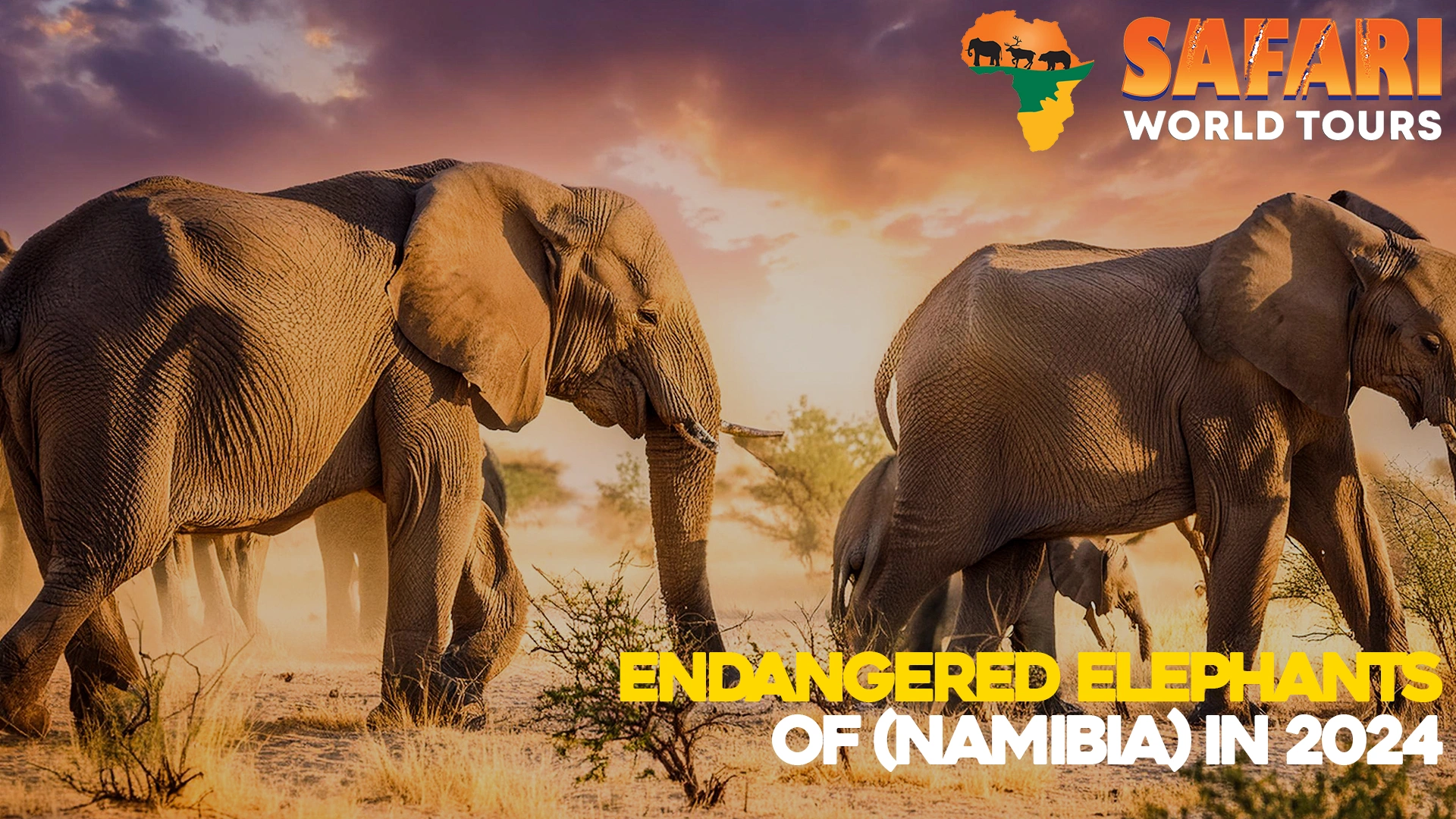Namibia ist ein wunderschönes Land, in dem es eine große Anzahl an Wüstentieren gibt. Besonders erwähnenswert sind die Wüstenelefanten Namibias (Loxodonta africana), die keine eigenständige Art sind, sondern einzigartig sind für ihre Anpassungsfähigkeit an Wüsten gefährdete Elefanten.
Es ist ihre Anpassungsfähigkeit an die Wüste, die sie von anderen Elefanten auf der ganzen Welt unterscheidet. Interessanterweise gibt es den an die Wüste angepassten Elefanten nur in Namibia und Mali. Diese Elefanten finden sich in der Damaraland und Kaololand Region von Namibia, das sich über 115.154 km2 Trockenland mit gefährdeten Elefanten erstreckt.
Dieser einzigartige Elefant hat die Aufmerksamkeit der International Union for the Conservation of Nature (IUCN) erregt, die ihn als vorrangig für den nationalen und internationalen Naturschutz eingestuft hat.

Wüstenelefanten sind kleiner und haben einen etwas längeren Rüssel, der es ihnen ermöglicht, auf der Suche nach unterirdischem Wasser tief in den Wüstensand einzugraben. Im Vergleich zu anderen Elefanten können sie Wasser problemlos über einen längeren Zeitraum in ihrem Rachen speichern.
Allerdings ist bekannt, dass sie weniger Wasser verbrauchen und nur alle 3 bis 4 Tage Wasser trinken. Das ist viel weniger als bei anderen Elefanten, die täglich über 200 Liter Wasser trinken (vom Aussterben bedrohte Elefanten).
Die Wüstenelefanten reißen keine Bäume aus und zerstören keine Pflanzen wie andere, die hoffen, in Zukunft wieder dorthin zurückzukehren. Angesichts der Knappheit an Pflanzen und Wasser haben sie gelernt, mit den begrenzten verfügbaren Ressourcen zu überleben.
Der vom Aussterben bedrohte Wüstenelefant

Die Population der Wüstenelefanten war einst sehr groß, doch die Wilderei bedroht weiterhin die Existenz dieser wunderbaren Tierwelt. In den letzten Jahren haben Aufzeichnungen einen drastischen Rückgang der Population gezeigt, bis 1990 waren es weniger als 300.
Die Wüstenelefanten werden nicht durch Grenzen eingeschränkt oder zurückgehalten; daher ziehen sie durch verschiedene Gebiete und geraten dadurch in Konflikt mit den Einheimischen. Der Konflikt zwischen Elefanten und Menschen wird auch auf die Gefährdung dieser Elefanten zurückgeführt, insbesondere bei Angriffen auf gefährdete Elefanten.
Außerdem wird der Lebensraum dieser Elefanten durch die Modernisierung und die Ausweitung menschlicher Territorien aufgrund landwirtschaftlicher Aktivitäten eingeschränkt, was dazu führt, dass die Elefanten in entferntere Länder zurückweichen.
Heute tragen die Bemühungen der namibischen Regierung und des Ministeriums für Umwelt und Tourismus zu positiven Ergebnissen im Kampf gegen Wilderei und andere Aktivitäten bei, die die Existenz dieser prächtigen, vom Aussterben bedrohten Elefanten weiter gefährden.
Die blühende Population der an die Wüste angepassten Elefanten wächst weiterhin, und jüngsten Statistiken zufolge liegt die Zahl bei fast 600.
Es gab jedoch Berichte über Trophäenjagd, da die Regierung angeblich einigen Leuten Jagdgenehmigungen für die Elefantenjagd erteilte. Die Praxis der Trophäenjagd wird jedoch vom Ministerium für Umwelt und Tourismus (MET) streng reguliert.
Die Vision der Regierung und ihr immenser Beitrag zu einer gemeinschaftsbasierten Naturschutzstrategie haben zu einem bemerkenswerten sporadischen Anstieg der Tierwelt geführt. Der an die Wüste angepasste Elefant ist in diesem Land mit seiner überwältigenden Schönheit und atemberaubenden Landschaft sehenswert. Während Sie Besichtigen Sie die fantastische SafariSie können auch die endemische Düne und die erstaunlichen, an die Wüste angepassten Löwen und vom Aussterben bedrohten Elefanten sehen.
Bedenken im Zusammenhang mit den gefährdeten Elefanten
Nach neuesten Schätzungen gibt es in Namibia nur noch etwa 600 an die Wüste angepasste Elefanten, was sie zu einer der am stärksten gefährdeten Elefantenpopulationen der Welt macht. Die namibische Regierung hat Schritte zum Schutz dieser Elefanten unternommen, indem sie Gesetze zur Verhinderung von Wilderei erlassen und gemeindebasierte Schutzprogramme für gefährdete Elefanten gefördert hat.
Diese Programme beziehen die örtlichen Gemeinden in die Artenschutzbemühungen ein und schaffen für sie Anreize, die Elefanten und ihren Lebensraum zu schützen.

Trotz dieser Bemühungen ist das Überleben dieser Elefanten weiterhin ungewiss. Da der Klimawandel die harten Umweltbedingungen, unter denen sie leben, immer weiter verschärft, werden ihre Nahrungs- und Wasserquellen immer knapper.
Darüber hinaus wird ihr Lebensraum durch die Ausbreitung menschlicher Siedlungen und Landwirtschaft immer weiter eingeschränkt, was zu vermehrten Konflikten zwischen Mensch und Tier und zur Gefährdung der Elefanten führt.
Um das Überleben der an die Wüste angepassten Elefanten in Namibia zu sichern, müssen konzertierte Anstrengungen unternommen werden, um die Ursachen ihres Rückgangs zu bekämpfen.
Dazu gehören verstärkte Schutzmaßnahmen, die Schaffung nachhaltiger Lebensgrundlagen für lokale Gemeinschaften, die von natürlichen Ressourcen abhängig sind, und die Förderung des Naturschutzbewusstseins in der breiten Öffentlichkeit. Durch Zusammenarbeit können wir sicherstellen, dass diese großartigen Geschöpfe weiterhin umherstreifen. Namibias Wüste Landschaften für kommende Generationen, gefährdete Elefanten.
FAQs
F: Warum sind an die Wüste angepasste Elefanten in Namibia vom Aussterben bedroht?
A: Die an die Wüste angepassten Elefanten in Namibia sind durch eine Reihe von Faktoren gefährdet. Dazu zählen Wilderei wegen ihres Elfenbeins, Verlust und Zerstückelung ihres Lebensraums sowie Konflikte zwischen Mensch und Tier.
F: Wie viele an die Wüste angepasste Elefanten gibt es noch in Namibia?
A: Den neuesten Schätzungen zufolge gibt es in Namibia noch etwa 600 an die Wüste angepasste Elefanten.
F: Was unternimmt die namibische Regierung, um die an die Wüste angepassten Elefanten zu schützen?
A: Die namibische Regierung hat Gesetze erlassen, um Wilderei zu verhindern und gemeindebasierte Naturschutzprogramme zu fördern. Diese Programme beziehen die lokale Bevölkerung in Naturschutzbemühungen ein und schaffen Anreize für sie, Elefanten und ihren Lebensraum zu schützen.
F: Wie kann ich helfen, die an die Wüste angepassten Elefanten in Namibia zu schützen?
A: Sie können Naturschutzorganisationen unterstützen, die sich für den Schutz der Elefanten in Namibia einsetzen, wie etwa den Save the Rhino Trust oder die Elephant Human Relations Aid. Darüber hinaus können Sie das Bewusstsein für die Notlage dieser Elefanten und die Bedeutung von Naturschutzbemühungen schärfen.
F: Was sind die größten Bedrohungen für das Überleben der an die Wüste angepassten Elefanten in Namibia?
A: Die größten Bedrohungen für das Überleben der an die Wüste angepassten Elefanten in Namibia sind Lebensraumverlust und -fragmentierung, Klimawandel und Konflikte zwischen Mensch und Tier. Diese Faktoren führen zu einem Rückgang der Nahrungs- und Wasserquellen sowie zu einem verstärkten Wettbewerb mit dem Menschen um Ressourcen.
F: Gibt es derzeit Bemühungen, die an die Wüste angepassten Elefanten in Namibia zu schützen?
A: Ja, in Namibia laufen mehrere Schutzbemühungen zum Schutz der an die Wüste angepassten Elefanten. Zu diesen Bemühungen gehören gemeindenahe Schutzprogramme, Maßnahmen gegen Wilderei und Forschung, um das Verhalten und die Ökologie der Elefanten besser zu verstehen.


